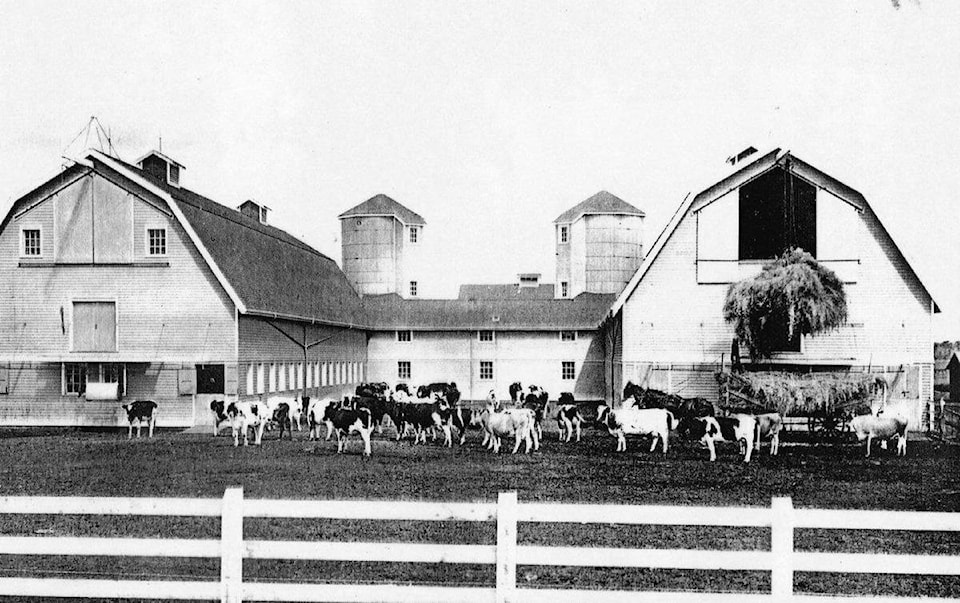By Mike Rainone for the News
Going into the 1920s the new Provincial Mental Hospital (PMH) near Ponoka was growing at a rapid pace of patient population, facilities, and qualified staff, all working together to provide a first class combination of excellent treatment as well as unique work and therapeutic programs and casual social activities.
In 1921, only nine years after the opening of the massive psychiatric facility, a complete farm operation was being built in the rolling hills just east of the main hospital.
The major construction of the PMH began July 1908, and at the same time plans were underway to provide additional land for the farm buildings that would be required to house a dairy herd and stables for horses. When the facility opened in 1911 a complete dairy herd was already in place as well as enough horses and equipment to put the first farm into operation, which also included hauling tons of coal with teams and wagons every day from the Canadian Pacific Railway station in Ponoka to the PMH power house. Mr. James Harris was the first hospital farm manager and Mr. Jones were in charge of the dairy, which by the end of 1924 was milking 113 cows and pasteurizing 171 gallons of milk daily and then shipping it to the main hospital.
With the farm in full operation by 1924 tragedy struck in 1926 when the new cow barns were destroyed by fire, but they were rebuilt immediately along with a farm manager’s house and a farm dormitory to accommodate the patient workers and farm hands. As success and demand grew throughout the rapidly growing PMH new piggeries were built up at the farm, poultry houses were enlarged, more land was required to raise crops and gardens, and a new slaughter house and creamery was added, the latter primarily for pasteurizing the milk. In the 1924 annual report submitted by PMH medical superintendent Dr. E. H. Cooke stated that the poultry operation at the hospital farm now consisted of 780 laying hens and pullets which were producing an average of 240 eggs each day. His immediate request to the provincial deputy of Health was to increase the flock to 1,500 birds as well as adding nine more poultry houses, three incubators, a milk cooler and clarifier, a large water tank for the barns, enough granaries to store 20,000 bushels of grain, and two (which eventually became four) large root-cellars to store the massive garden crops of potatoes, turnips, onions, and other produce. Thank goodness that these requests were mostly completed in those hectic early years, as the patient population of the PMH would grow rapidly to average 1600 by the 1940s.
Farm cultivation was done by the farm staff while the garden staff tended to the eventual 48-acres of vegetable gardens, with the exception of the potato production, which was completed annually by the farm staff. Plowing, seeding, cultivation, and digging were all done by horse-drawn machines, while the picking and sacking of the close to the annual crop of 13,000 pounds of potatoes were done by hand by over 100 men, who were recruited from the hospital wards and who all received a hardy lunch and a package of tobacco for their efforts.
The actual raising of the crops, including hay, green feed, and grain was done by the farm staff with able help from other patients, but when 60 more acres were added to the mix the heavier workload was assisted by the purchase of the farm’s first second hand Rumley Oil Pull tractor (16-30) and a Sawyer-Massey Separator. As well as the tons of vegetables that were harvested annually on the grounds surrounding the farm site, a three acre nursery garden was added to the greenhouses on the main hospital sight, which consisted of 1000 raspberry canes and numerous varieties of small trees, fruits and berries.
Many of the work crews from the farm and the hospital wards also took part in the spring and summer care and preparation of the massive and always immaculately groomed grounds surrounding the hospital, including trimming lawns, cultivating, planting and weeding the magnificent flower beds, and then working on snow removal in the winter months. Not only did the patients and staff on the wards receive an ongoing year-round supply of fresh vegetables and farm products, they were also blessed with all sorts of amazing potted flowers and plants in all areas.
The earliest transportation for workers and patients was by horse and wagon or on foot, but to meet the increasing demands of the hospital and the grounds the first school bus was built in the garage, fashioned from the chassis of a large touring car once owned by a rum-runner in the Blairmore. A heavy steel roof and seats were added and the big bus offered lots of ‘rough riding’ for the children going to the Ponoka town schools, as well as picking up mail and supplies, and for many other daily duties.
The PMH farm and gardens became such a huge and productive operation over the years that in the late 1940s more staff and patients’ help was required, as well as additional dormitories and repair because of several fires. These operations at the Ponoka hospital had now become so much more for than self-sufficient and successful, which allowed them to provide supplies to the psychiatric treatment hospitals at Raymond, Claresholm, and AHP Edmonton, which always included an ample gift of hundreds of big Christmas turkeys and all the trimmings.
Unfortunately all good things must come to and end, and in 1962 the large scale gardening program was discontinued, while the Alberta hospital farm, which over a span of five decades had become an internationally recognized institutional work and therapy program as well as a productive supply operation was closed and all of the farm buildings were sold or demolished.
